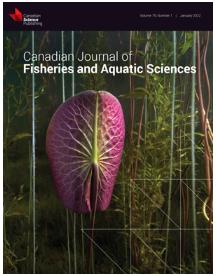A conversation with Dr. Natasha McDonald, Director, Peer Review at Canadian Science Publishing
 When the non-profit scholarly publisher Canadian Science Publishing became a Dryad partner in January 2024, the editors had a clear aim in mind: to support authors in meeting new, more robust data availability requirements, which journal editors were advocating for. Dryad’s community non-profit status, exceptional metadata standards, and hands-on human support from experienced data curators aligned well with CSP’s own mission and data sharing goals.
When the non-profit scholarly publisher Canadian Science Publishing became a Dryad partner in January 2024, the editors had a clear aim in mind: to support authors in meeting new, more robust data availability requirements, which journal editors were advocating for. Dryad’s community non-profit status, exceptional metadata standards, and hands-on human support from experienced data curators aligned well with CSP’s own mission and data sharing goals.
After nearly two years of partnership, we caught up with CSP’s peer review director Dr. Natasha McDonald to learn more about the implementation of their data policy, researcher response, and lessons learned. Read our conversation below.
Let’s begin with a little background on Canadian Science Publishing and your approach to data availability. Why is data a priority for the organization? What are your overall goals with regard to data sharing at CSP?
At Canadian Science Publishing (CSP), we support the FAIR (findable, accessible, interoperable, and reusable) data principles as well as the FORCE11 Data Citation Principles. Authors are encouraged to share the minimal data necessary to allow for reproducibility of their findings. We recognize that access to data is a critical component of open and transparent science. Ultimately, we would like for additional journals in our portfolio to adapt open data policies.
I understand that you have recently updated your data availability policy: what was the scope and the main purport of that change? How is it different from your previous approach?
Last year we introduced more rigorous open data policies for two of our journals: the Canadian Journal of Fisheries and Aquatic Science (CJFAS) and the Canadian Journal of Physiology and Pharmacology (CJPP). For these journals, authors must provide the minimal data set needed to replicate the study, by the time of publication. They must also provide a DataCite DOI for the data, which must be publicly accessible. While we have always encouraged this level of data sharing at CSP, this is the first time we have made it a requirement for publication.
What convinced you that the time was right for a more stringent policy?
Some of the editors and the Editors-in-Chief at CJFAS raised the issue to us — they felt frustrated by the lack of data sharing and felt that without a formal policy, their hands were tied in compelling authors to share the data underlying the results of their study. As such, we launched the policy and when the Editor-in-Chief of CJPP heard about the initiative, he asked about a similar policy for his journal as well.
Was the author response in line with your expectations? Have you found that authors were easily able to prepare and provide data for public consumption?
We predicted that some authors would find the policy challenging, so we built clear exemptions into the policy — for example, studies involving sensitive data on human participants or Indigenous data. Authors also have until the time of publication to make their data public and provide us with the DOI. Additionally, our partnership with Dryad is intended to make data sharing easier for our authors.
CSP has partnered with Dryad to make data curation and publication free for authors at four of your journals: Arctic Science, the Canadian Journal of Fisheries and Aquatic Sciences, Drone Systems and Applications, the Canadian Journal of Physiology and Pharmacology and FACETS. What was your strategy in selecting those publications?
 Two of these journals feature our new open data requirements, and as such, we wanted to provide an option for authors to upload to a reputable, non-profit repository, where they could get assistance from data curators. Additionally, we included our Open Access journals in the partnership to provide readers with a more ‘open’ knowledge experience. It is a bit counter-intuitive to have Open Access, yet ‘closed’ data.
Two of these journals feature our new open data requirements, and as such, we wanted to provide an option for authors to upload to a reputable, non-profit repository, where they could get assistance from data curators. Additionally, we included our Open Access journals in the partnership to provide readers with a more ‘open’ knowledge experience. It is a bit counter-intuitive to have Open Access, yet ‘closed’ data.
What do you see ahead for data availability or Open Science in general at CSP?
We look forward to rolling out open data policies for additional journals in our portfolio and some upcoming new journals. We feel that this is a great way to increase the impact of research and to maximize societal benefit.
Any tips for other publishers looking to experiment with data availability standards?
We would suggest starting small, with one or two journals to identify barriers and challenges and determine how to address them before proceeding. We also have found that close communication with authors alleviates a lot of their concerns and helps them to understand the impetus for the policy.
The Canadian Science Publishing / Dryad collaboration illustrates how strong, well-aligned, synergistic partnerships can empower change. And, how a policy for one or two journals can form the thin end of a wedge that opens the door to more transparent research practice broadly.